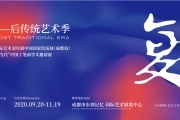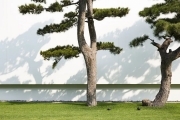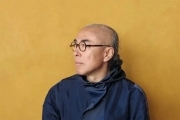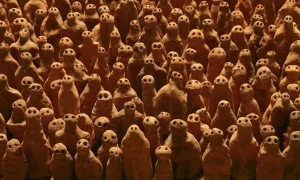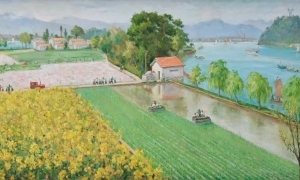Fabien Fryns
草场地F2画廊的主人Fabien Fryns表示,他并不担心金融危机。
“中端艺术品已经退出市场,但高端和低端还很强劲。”
什么是中端?按照他的说法就是价格3万至50万美元的作品。
与股票市场,或者其他投资市场相比较,中国当代艺术仍然是一个不错的投资选择。
一些北京最好的画廊主都认为,震荡重组对经销商和艺术家来说都是一个积极的发展机会。没有人喜欢泡沫,越来越多的人都认识到,财富来得太容易会摧毁艺术家的创造力。
栗宪庭
被认为是“当代艺术运动精神之父”的前《中国美术》杂志编辑栗宪庭认为,媒体宣传将许多艺术家制造成了“金钱偶像”,衍生了一种扭曲的艺术形式。
刚从纽约回来的雕塑家和画家潘兴磊认为,金融危机能够淘汰那些不认真的艺术家,“认真严谨的艺术家可以借此机会反思并改进自己的想法,而其他人将会被淘汰。”
2005年,苏富比成立了亚洲当代艺术部,并开始收购相关作品,火热的中国当代艺术开始引起国际广泛关注。
“情况开始变得复杂和困难,因为许多艺术家都被宠坏了,”Fryns说,“过去这几年的情况相当疯狂,你只有一个小时的时间来决定是否买一件作品。”
2006年3月,一场预期拍卖额为600万美元的拍卖会最后销售额为1300万美元。2007年,岳敏君的一幅作品卖出了590万美元。
许多中国的百万富翁们开始向艺术领域投资。“他们都不了解是什么使得当代艺术如此成功,因此他们都去买那些最高价的作品。”Fryns说。
Brian Wallace
798已经成为北京最受欢迎旅游目的地第三名,但是同时,一些更独立的画廊和更认真的艺术家已经转移到更加偏远的地区,比如宋庄和草场地。
红门画廊的经营者Brian Wallace指出,798似乎正在从画廊发展成买卖市场,但是他也毫不怀疑中国将会继续为当代艺术投入巨大的创造力和高招技艺。
“在中国,艺术是一种职业道路,”Brian Wallace说,“就像成为一个医生或律师一样。”
经济衰退对房地产的影响联系到艺术身上将会是另一种情况。作为第一家关注当代艺术的独立美术馆,今日美术馆很可能会取得成功。
Fryns则表示F2和其他一些画廊更喜欢位置偏远的草场地,因为这里有许多合理空间。如果一位收藏家想要飞到北京来买一幅画,他能很容易就找到这里。同时,他还坚信,从长远来看,最好的艺术品一定会保持它的价值。“当今市场上真正高质量的东西很少,大家都抓紧手里有的东西。而中国有许多新兴的亿万富翁,一旦他们拥有了一些东西,他们就有可能转向当代艺术市场,想要收藏中国最好的东西,但是这些东西的数量是有限的。”
(来源:globepost,点击参看原文)
【编辑:张明湖】
Chinese art — not a bust
Beijing artists and gallery owners say the economic downturn will improve quality.
BEIJING — Fabien Fryns, who runs the F2 gallery in Caochangdi village on the outskirts of Beijing, does not look like a man who is worried about the financial crisis.
“The middle has dropped out of the market,” said Fryns, discretely smoking a cigar in the gallery’s voluminous interior garden, “but the top and the bottom are both strong.”
What is "the middle"? Pieces from $30,000 to $500,000, according to Fryns.
Compared to the stock market, or nearly any other place one can put one’s money these days, Chinese contemporary art still looks like a very good investment. Recent art auctions in Hong Kong have registered sales at the high end of their estimates, even though the targets the auction houses are setting for themselves are less ambitious today than previous years.
The owners of some of the best Beijing galleries said the shakeout promises to be a positive development for dealers, but also for artists. No one likes a bubble and there was growing concern that easy riches were destroying creativity by encouraging Chinese artists to go after major sales, rather than the real thing.
Li Xianting, the former editor of the magazine China Fine Arts who is considered the spiritual father of the contemporary art movement, said media hype transformed many artists into “money celebrities” and produced a twisted form of art.
Pan Xing Lei, a sculptor and painter who recently returned to Beijing from New York, said the financial crisis would weed out less serious artists.
“The artists who are serious can take this time to reflect and to develop their ideas,” he said. “The others will go back to their villages, or do something else.”
The craze over contemporary Chinese art began to trigger serious waves on the international art scene in 2005, after the auction house Sotheby’s established an Asian contemporary art department and began buying up works. Many of the artists were reacting to the Tiananmen Square massacre and grappling with the wrenching changes in Chinese society, a fact that made them especially interesting as an emerging China began to make its influence felt in other domains.
“The relationship was becoming difficult because many of the artists were spoiled,” Fryns said. “The scene in the last few years was crazy. You were given an hour to decide if you wanted to buy a piece.”
In March 2006, an auction that was expected to bring in $6 million raised $13 million. In 2007, a single painting, “Executioner,” by Yue Minjun, famous for his cynical-realist political pop caricatures of himself with a frozen smile, went for $5.9 million, up from the $32,200 the original owner had paid a decade earlier.
With results like that, China’s own millionaires, many of them newly minted, began buying art mostly as investment.
“None of them had time to study what it was that was making contemporary art so successful,” Fryns said, “so they bought the pieces that were going for the highest prices.”
A sprawling gallery complex known as 798, which occupies a former military factory complex, became the third most popular tourist destination in Beijing. By the time it had succeeded, however, the more exclusive galleries and many of the more serious artists had already moved to more remote art villages, including Songzhuan and Caochangdi, where F2 is located.
Brian Wallace, who runs the Red Gate Gallery in an ancient guard tower on a remnant of the city’s original Ming wall, noted that 798 seems to be evolving from gallery space to retail space. But Wallace had no doubt that China will continue to inject enormous creativity and professionalism into the contemporary art scene.
"Art is a career path in China,” Wallace said. “It is like being a doctor or a lawyer.”
The recession’s impact on real estate speculation connected to art may be a different story. Beijing’s dazzling Today Art Museum, the city’s first independent museum focusing on contemporary art, will probably succeed. But a flashy nearby gallery complex known as 22 Art Plaza International, which had intended to capitalize on the museum’s attraction, stands largely empty.
Fryns said F2 and other leading galleries prefer the more remote location at Caochangdi, because the space is reasonable, and there is a lot of it. A collector who has flown to Beijing, ready to spend a million dollars or more on a painting, has no difficulty finding the location.
“We don’t get the drop-in crowd, the casual passers-by, the young couple with cameras, but that is not what we're looking for,” Fryns said.
And Fryns is convinced that in the long term, the best art will continue to hold its value. “There is very little quality material coming on the market today,” he said. “People are holding on to what they have. There are a lot of newly wealthy Chinese billionaires. Once they have bought everything else, a certain number will turn to contemporary art. They will want to collect the best work that is Chinese, and there is a limited supply of that."
(来源:globepost,点击参看译文)



